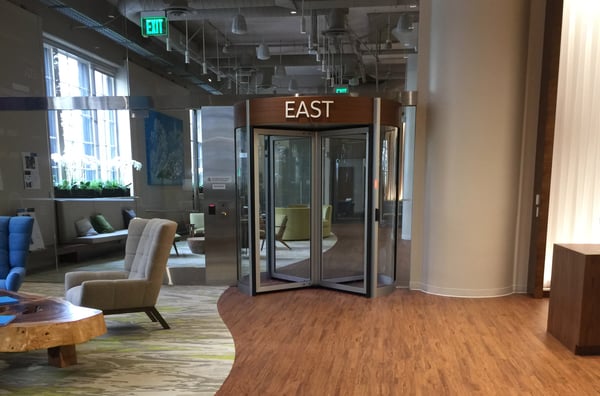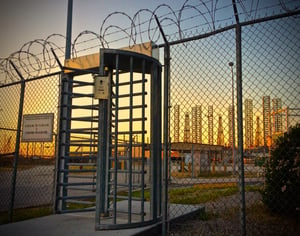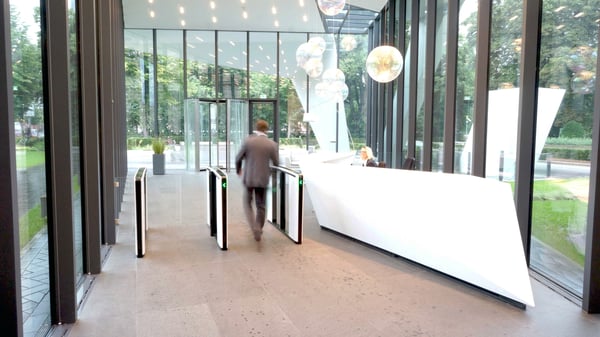Welcome to the fourth installment of our S.T.A.R.T.S.S. blog series! In this series, we are taking a deeper look at our S.T.A.R.T.S.S. decision methodology, which guides you in choosing the best security entrances to meet your exact security and organizational needs. Click here to learn more by reading the series’ introductory blog.
Today’s topic: Aesthetics
Dictionary definitions of aesthetics tend to focus on considerations of style and beauty. While those elements are important, a consideration of aesthetics should also include the practical factors of the real world and the passage of time. We want to include these elements because the overarching goal of this series is to make the best possible selection when choosing a security entrance. In that context, we’ll explore how an interplay of colors, materials and finishes impacts not only how an entrance looks when it is first installed, but how well it supports business objectives over time.
Style, Beauty and Meaning
Tastes vary widely among people, so what some people might find beautiful, others may find less so. As security entrance manufacturers, we have a lot of experience with this challenge, so we provide options for colors, materials and finishes that let organizations adjust the appearance of their entrance systems to match their priorities and preferences. Depending on the specifics of a particular entrance design, the choices may apply to particular parts of the unit, or the unit as a whole. And, the appearance of an entrance may convey a meaning or message that goes beyond the entrance itself.
 Some things to consider when choosing the appearance of an entrance include:
Some things to consider when choosing the appearance of an entrance include:
- Colors and style of the surrounding lobby or entrance area
- Corporate or branding colors
- How much the entrance should stand out from the surroundings
- High-tech versus more traditional appearance
- Color-coding to aid in entrance use or other purpose
Practical Matters
 Beyond the type of finish and general appearance, we also need to consider some practical matters – for example, what kind of environment will the entrance experience? If entrances will be exposed to the outdoors, then we need to take that into account, and that fact may affect the finish choices. What level of cleanliness is required, and how will cleaning be managed? Some finishes are easier to clean than others, and some will show fingerprints and dust more than others.
Beyond the type of finish and general appearance, we also need to consider some practical matters – for example, what kind of environment will the entrance experience? If entrances will be exposed to the outdoors, then we need to take that into account, and that fact may affect the finish choices. What level of cleanliness is required, and how will cleaning be managed? Some finishes are easier to clean than others, and some will show fingerprints and dust more than others.
Here are some practical matters that should be included in your consideration:
- Indoor installations will generally have the greatest number of suitable finish choices, because both robust and less-robust finishes can be considered.
- Installations exposed to the outdoors should have a finish that can stand up to the elements, such as a galvanized aluminum.
- If the installation will be in direct sunlight, the color and finish will be affected by the amount of heat energy absorbed. Will reflections be an issue?
- How often will the entrances be cleaned, and for what purpose? For example, fingerprints and dust may show more clearly on certain colors and finishes.
- What kind of cleaners will need to be used – for example, if the entrance will be near chemicals, laboratories or other special areas?
The Passage of Time
Ensuring that the entrance will continue to look as desired over time brings another set of considerations. This is clearly true for outdoor installations, but our long experience maintaining security entrance installations has taught us to ask about other circumstances based on the long life of these products.
Here are some considerations regarding the passage of time:
- If the installation will be outdoors, can some protection be provided – by a building overhang or a canopy, for example, to extend the life of the color and finish? This can be helpful for protecting full-height turnstiles installed at a perimeter fenceline, for example.
- If the installation will be in direct sunlight, will the color fade over time?
- Entrances installed near saltwater must have a special coating to prevent rust and quick wear of the finish.
- Some finishes have special properties that can extend their life – electro-polished stainless steel, for example, has a bright, clean appearance which also offers excellent corrosion resistance.
- “Painted” surfaces may be painted with acrylics or nitrocellulose lacquers, but powdercoating is usually used for increased durability. Powdercoating is tough enough for most traffic situations, but for very high traffic levels, consider using solid materials such as stainless steel in areas that will be touched or exposed to wear.
- And, consider potential changes in corporate colors, branding or lobby design that may suggest color changes within the expected life of the entrances. In these cases, confining the colored areas to panels that are easily replaced will allow for easier changes in the future.

Next Step
What color and finish choices are available for the security entrances in your selected security level? Does your facility represent a single organization, in which case you can choose to display the corporate colors, or is it a multi-tenant facility that can choose a style that matches the prestige level of the public lobby? Check your color and finish choices against your organizational priorities, and use the points above as your guide.
Stay tuned for Topic #4, ROI.
Please feel free to contact us directly with any questions – we love to help.

